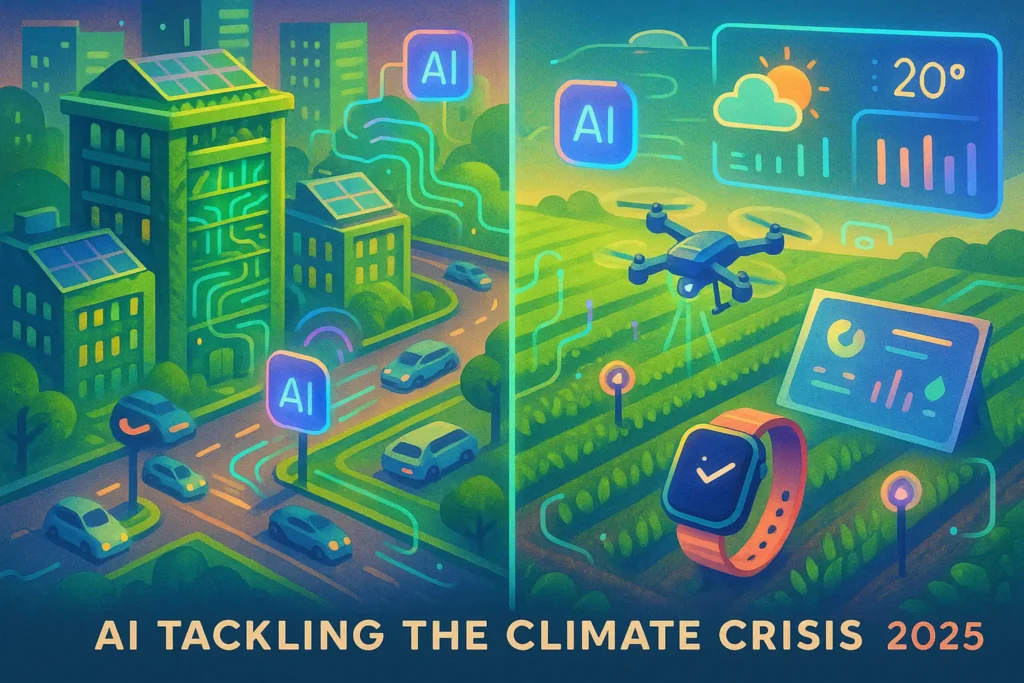🧠 Why AI May Be Our Most Powerful Ally Against Climate Change
Climate change is no longer a distant threat—it’s happening now. From rising sea levels to record-breaking wildfires, the effects are intensifying. The challenge is immense, urgent, and deeply complex. But amidst the chaos, one tool is emerging as a game-changer: Artificial Intelligence.
In 2025, AI isn’t just about chatbots or automation—it’s powering the fight for our planet. From smart grids optimizing energy flow to machine learning models predicting climate disasters, the role of AI in environmental resilience is rapidly evolving.
And unlike human systems burdened by politics and inefficiency, AI can act with scale, speed, and precision.
Let’s explore how intelligent systems are shaping a greener, more sustainable future.
⚡ AI-Powered Energy Management: Smarter, Cleaner Grids
Energy production and consumption are at the heart of the climate problem. Fossil fuels account for over 70% of global greenhouse gas emissions. But the solution isn’t just switching to renewables—it’s managing them intelligently.
AI enables:
-
Smart Grid Optimization: Algorithms analyze real-time demand, weather conditions, and storage capacity to balance power distribution and reduce waste.
-
Demand Forecasting: Utilities use predictive AI to forecast spikes in usage and shift loads accordingly.
-
Energy Efficiency: AI systems in homes and offices learn usage patterns to optimize HVAC, lighting, and appliances.
💡 Companies like Google DeepMind have already reduced data center cooling energy by over 30% using AI—proof that AI can make sustainability profitable.
For a deeper dive into smart infrastructure, see Smart Cities: How AI and IoT Are Shaping Urban Life.
🌍 Climate Modeling with Machine Learning
Traditional climate modeling relies on physics-based simulations that are often resource-intensive and slow. AI introduces a paradigm shift:
-
Neural Weather Models: ML algorithms now process satellite, ocean, and atmospheric data faster than supercomputers.
-
Localized Forecasts: AI enables high-resolution predictions for specific cities or regions, helping local authorities make timely decisions.
-
Scenario Simulation: Deep learning models test hundreds of “what-if” climate scenarios to aid long-term policy planning.
Startups and research labs are building AI systems that simulate decades of climate data in minutes, offering previously impossible insights.
This innovation aligns with many Emerging AI Trends to Watch in 2025—particularly around real-world problem-solving over theoretical research.
🔥 Predicting Wildfires, Floods, and Droughts Before They Strike
One of AI’s most powerful contributions is predictive disaster management:
-
Wildfire Detection: Satellite imagery + AI = early detection of heat spots and flame spread patterns
-
Flood Risk Mapping: ML models analyze terrain, weather, and infrastructure to predict where floods will hit hardest
-
Drought Forecasting: By analyzing rainfall history, soil data, and crop stress signals, AI helps farmers prepare ahead of time
Tools like IBM’s Watson Decision Platform are already in use in South America and Africa to provide early warnings and save lives.
This is more than tech—it’s climate resilience at scale.
🌾 AI in Sustainable Agriculture: Feeding the Planet, Not the Problem
Agriculture contributes to both greenhouse gas emissions and deforestation. But it can also be a key to reversing the crisis—if managed sustainably with AI.
Key innovations include:
-
Precision Farming: AI drones and sensors monitor crops in real-time to reduce water and fertilizer use
-
Yield Forecasting: ML models help predict harvest success, optimizing supply chains and reducing waste
-
Climate-Resilient Crops: AI-assisted research identifies traits for heat/drought resistance and genetic adaptation
By combining AI with green practices, farmers are turning agriculture into part of the solution, not just the problem.
This overlaps directly with breakthroughs we discussed in AI in Everyday Life—especially how rural economies are being transformed through accessible intelligence tools.
🏙️ Smart Environmental Policy & AI-Governed Green Cities
What if climate policies were based not on politics—but on data-driven logic? That’s where AI comes in.
How Governments Are Using AI:
-
Urban Planning: AI helps design low-emission cities with optimized traffic flow, public transport, and green spaces
-
Environmental Monitoring: Sensors + AI track pollution levels, noise, and temperature in real time
-
Carbon Tax Modeling: Machine learning assesses economic impact and fairness of carbon regulations
-
Policy Simulation: Predictive systems model the long-term impact of environmental laws before they’re enacted
Cities like Singapore, Amsterdam, and Helsinki are implementing these systems today—not in theory.
If you’re interested in how tech redefines urban living, check out AI & Future Tech Predictions for the Next Decade and The Rise of AI CoPilots for cross-sector synergy
📉 Where AI Still Falls Short in Climate Efforts
While AI offers massive potential, it’s not a silver bullet—and it’s crucial to acknowledge its current limitations if we want to deploy it responsibly.
-
Data Gaps: Many developing countries lack sufficient, reliable climate data. This limits the accuracy of AI predictions in the regions that often need it most.
-
Bias & Blind Spots: AI models trained on limited datasets may overlook vulnerable communities or rare climate patterns.
-
High Energy Cost: Ironically, large AI models (including climate models) can consume enormous computational resources, sometimes offsetting their green benefits.
-
Opacity: Many AI systems function as “black boxes.” That’s problematic when decisions—like evacuation or infrastructure investment—depend on them.
To move forward, transparency, global data collaboration, and human-AI cooperation must evolve together.
📬 Want More Smart AI x Climate Insights?
Join our free newsletter and get weekly breakdowns of how AI, sustainability, and emerging tech are reshaping our world—delivered straight to your inbox.
No hype. Just practical, future-focused ideas for builders, creators, and change-makers.
🔐 100% privacy. No spam. Just signal, not noise—by NerdChips.
🌐 Notable Projects & Startups Driving AI + Climate Innovation
AI-powered climate solutions aren’t just concepts—they’re already out there, in the hands of scientists, farmers, and policymakers.
Here are some real-world initiatives worth watching:
-
🔬 ClimateAI – Predicts agricultural disruption and supply chain risk due to climate shifts
-
🛰️ Descartes Labs – Uses satellite imagery + ML for land use, fire risk, and environmental monitoring
-
⚡ WattTime (by RMI) – Optimizes power grid usage to reduce real-time CO2 emissions from electricity
-
🌍 Google Earth Engine – Offers planetary-scale datasets for researchers to model deforestation, flooding, and more
-
🌱 Blue River Tech – A John Deere-backed startup using computer vision for precision spraying and water use
These aren’t just tools—they’re examples of how innovation scales action, not just awareness.
🧠 Who Controls the Climate AI? The Ethics You Should Know
Deploying AI in climate-related systems isn’t just a technical issue—it’s also deeply ethical.
Questions we must confront:
-
Who owns the models? Many climate AI systems are developed by corporations or defense-linked entities. Should critical infrastructure depend on private code?
-
Whose data is used? Farmers in rural Africa or Indigenous land stewards might unknowingly contribute to datasets used by global tech giants.
-
Who gets the benefits—or the harm? If AI directs resources toward high-income areas while neglecting vulnerable zones, climate injustice is perpetuated.
-
What happens when it fails? Misguided models could lead to unnecessary evacuations, policy mistakes, or loss of trust in tech-based climate responses.
That’s why ethical frameworks—like open sourcing, community validation, and localized adaptation—must be part of any scalable climate AI roadmap.
🧠 Nerd Verdict
AI is not a magic bullet. But it is our most scalable, adaptive tool to fight the climate crisis.
Its greatest strength? Turning chaotic, nonlinear, global problems into actionable insights and predictions.
Whether managing city power grids, predicting wildfires, or designing next-gen crops, AI is helping us move from reaction to prevention.
The challenge now is ensuring access, transparency, and ethics keep pace with innovation.
Tech doesn’t have to be extractive. With the right vision, it can be regenerative.
❓ FAQ: Nerds Ask, We Answer
💬 Would You Bite?
If AI could solve just one part of the climate crisis, which would you want it to tackle first—energy, food, cities, or disaster prevention?
Share your thoughts 💬



